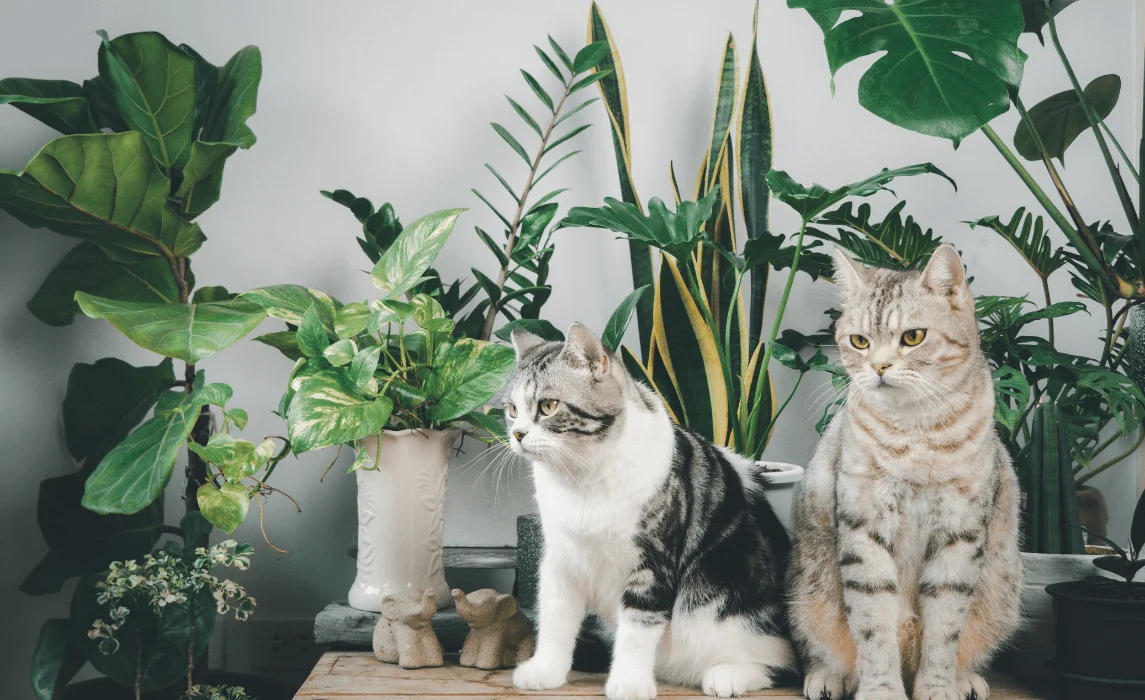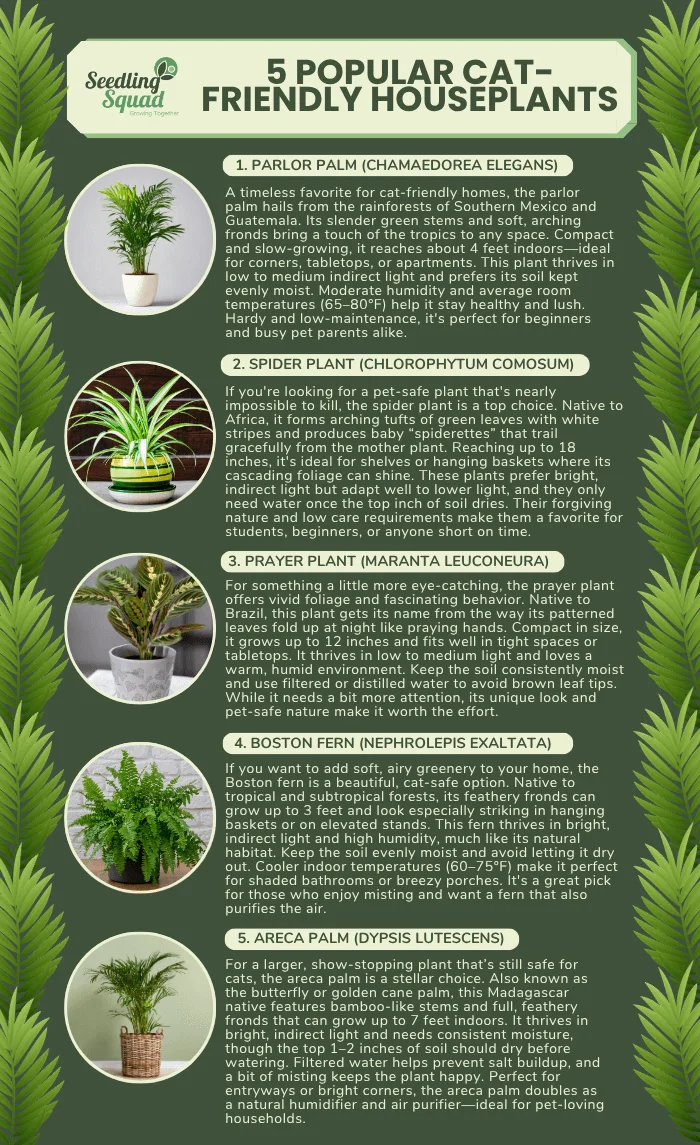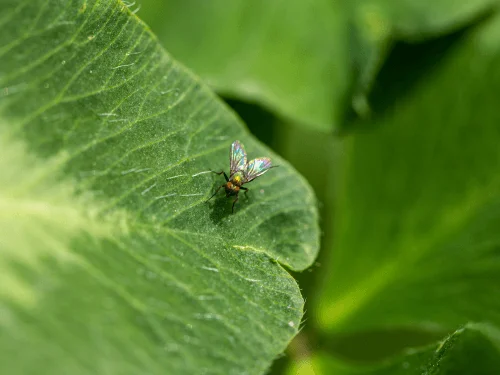Cat-Friendly Houseplants: The Best Indoor Plants That Are Safe for Cats and Perfect for Any House Plant Lover

Q1: How long does it take to grow a watermelon?
Watermelon growing time varies by variety. Most watermelons take about 75–100 days from planting seeds to harvest. Seedless watermelons often take slightly longer. Starting seeds indoors can give you a head start, especially in shorter growing seasons.
Q2: Can I grow watermelon in a pot or container?
Yes! Small or icebox varieties like Sugar Baby grow well in large pots (15–20 gallons). Ensure the container has good drainage, is filled with fertile, well-draining soil, and gets full sun daily. Water frequently, as pots dry faster than garden beds, and provide a trellis or allow vines to trail over the sides.
Q3: Can watermelons grow in raised garden beds?
Absolutely! Raised garden beds are ideal because they warm up faster in spring and provide excellent drainage. Space plants well, enrich the soil with compost, and mulch around vines to maintain moisture and control weeds.
Q1: How can I identify common insects in my garden?
A: Look for signs such as holes in leaves, leaf miner damage, egg clusters, or wilting. Inspect the undersides of leaves, stems, and roots for adults and larvae of moths, sawfly, cabbage looper, tomato hornworm, and European corn borer.
Q2: What natural methods can control pests?
A: Encourage beneficial insects like ladybugs and parasitic wasps, handpick pests, squish caterpillars and slugs, prune infested leaves, and use DIY sprays like neem oil or spinosad. Row covers can also repel moths, sawfly, and cabbage white.
Q3: How can I prevent pests in my garden?
A: Maintain garden hygiene, remove debris, rotate crops, use companion planting, encourage beneficial insects, and inspect leaves and roots for early damage. Row covers and DIY sprays also help prevent infestations.
Q4: How do pests cause plant diseases?
A: Pests spread blight and bacterial wilt through feeding wounds. Early identification, removing infested plants, natural pest control, and healthy soil help minimize disease.
1. Can I grow fruit trees in small gardens or pots?
Yes! Many dwarf fruit trees and container-friendly varieties are perfect for small gardens or patios. Trees in pots can include citrus trees, figs, and dwarf apple trees. Using containers allows you to control soil, water, and temperature more easily, making it possible to grow fruit even in northern climates. These trees are especially useful if you want fast-growing trees that produce fruit within a few years and don’t require a large orchard space.
2. What climate is best for fruit trees?
The climate plays a major role in fruit production. Cold-hardy trees like apples, pears, and plums survive in northern regions, including zone 3, while citrus trees, figs, and peaches thrive in warmer southern areas like Florida or Virginia. Some fruit trees may require protection from frost, while others can tolerate cold winters. Understanding your USDA zone and local conditions ensures your trees will grow healthy and produce fresh fruit consistently.
3. Where can I buy fruit trees online?
Many growers offer fruit trees for sale online, including bare root trees, grafted trees, and container-grown trees. Buying fruit trees online allows you to select from a wide range of fruit tree varieties suitable for your climate, including apples, pears, peaches, plums, citrus trees, and more. When purchasing, check for USDA zone compatibility, tree size, and health guarantees to ensure you receive a quality tree that will thrive in your garden.
If you’re a cat lover and a houseplant enthusiast, you’ve probably faced the dilemma of choosing between a lush indoor jungle and your feline friend's safety. Luckily, you don’t have to compromise. There’s a wide variety of stunning, non-toxic plants that can thrive indoors and coexist peacefully with your curious kitty. In this guide, we’ll explore the best cat-friendly houseplants that are not only safe for cats but also perfect for brightening up your space. Whether you’re a seasoned plant parent or just starting your indoor garden, these pet-safe picks will help you create a vibrant, cat-happy home.
10 Cat-Friendly Houseplants

1. Parlor Palm (Chamaedorea elegans)
.webp)
The parlor palm is a timeless classic in indoor plant décor and a favorite for cat-friendly homes. Native to the rainforests of Southern Mexico and Guatemala, this slow-growing houseplant features slender green stems topped with soft, arching fronds that bring a gentle tropical flair to any room. Indoors, it typically grows up to 4 feet tall, making it a manageable size for tabletops or corners. Parlor palms thrive in low to medium light, tolerating shade better than many other tropical species. They prefer evenly moist, well-draining soil and appreciate occasional misting to mimic their native humid environments. Avoid overwatering or letting them sit in soggy soil. With their hardy nature and tolerance for average room temperatures between 65–80°F, these palms are ideal for apartments and small spaces. They’re perfect for beginner plant parents, busy cat owners, and lovers of vintage-style houseplants who want something lush and safe.
Soil: Well-draining potting mix
Water: Moderate; let top inch dry between watering
Light: Low to medium indirect light
Humidity: Moderate
Fertilizer: Monthly during growing season with diluted liquid fertilizer
Temperature: 65–80°F (18–27°C)
USDA Zone: 10–12
2. Spider Plant (Chlorophytum comosum)
.webp)
Spider plants are among the easiest houseplants to care for, and they’re completely safe for curious cats. Native to tropical and southern Africa, these resilient plants form grassy tufts of arching green leaves with white stripes, sending out trailing stems that produce baby plantlets resembling little spiders. They typically reach 12–18 inches tall and wide and are ideal for hanging baskets or shelves where their cascading foliage can be appreciated. Spider plants adapt to a wide range of conditions and are particularly forgiving for new gardeners. They thrive in bright, indirect light but tolerate low light as well. Water when the top inch of soil feels dry, and ensure good drainage to prevent root rot. They enjoy slightly humid conditions and average indoor temperatures between 60–80°F. Spider plants are well-suited for busy pet parents, students, or anyone looking to fill their space with greenery without a lot of maintenance.
Soil: Loamy, well-draining soil
Water: Water when top inch is dry
Light: Bright, indirect light; tolerates low light
Humidity: Moderate to high
Fertilizer: Monthly during growing season
Temperature: 60–80°F (16–27°C)
USDA Zone: 9–11
3. Prayer Plant (Maranta leuconeura)
.webp)
Known for its dramatic foliage and fascinating nightly movements, the prayer plant is a striking, cat-safe option for indoor plant lovers. Originating from the tropical forests of Brazil, this plant gets its name from the way its leaves fold up at night, resembling praying hands. It typically grows up to 12 inches tall and wide and features oval leaves patterned with vibrant green, red, and purple hues. Prayer plants prefer low to medium indirect light, making them great for spots that don’t get much sun. They thrive in warm, humid environments and need consistently moist, but not soggy, soil. Avoid letting the soil dry out completely. They also prefer distilled or filtered water, as fluoride and chlorine can cause leaf tips to brown. With its decorative look and moderate care needs, the prayer plant is ideal for patient plant lovers who enjoy nurturing visually interesting plants in smaller indoor spaces.
Soil: Peat-based, well-draining mix
Water: Keep evenly moist, avoid drying out
Light: Low to medium indirect light
Humidity: High
Fertilizer: Every 2–4 weeks during growing season
Temperature: 65–75°F (18–24°C)
USDA Zone: 11–12
4. Boston Fern (Nephrolepis exaltata)
.webp)
The Boston fern is a fluffy, feathery houseplant that brings instant texture to any indoor space—and it’s completely safe for your feline friend. Native to tropical and subtropical regions, this fern has long arching fronds made up of delicate green leaflets. Indoors, it can reach 2–3 feet tall and wide, often looking its best when placed in hanging baskets or on pedestal stands. Boston ferns thrive in bright, indirect light and high humidity, mimicking their native forest floor conditions. Keep their soil consistently moist, but not waterlogged. They do not like to dry out. These ferns prefer cooler indoor temperatures between 60–75°F, which makes them ideal for shaded bathrooms, sunrooms, or porches. They’re a great match for plant parents who don’t mind misting regularly and want a soft, pet-safe touch of greenery that also acts as a natural air purifier.
Soil: Rich, well-draining potting mix
Water: Keep soil moist, avoid drying out
Light: Bright, indirect light
Humidity: High
Fertilizer: Monthly with balanced liquid fertilizer
Temperature: 60–75°F (16–24°C)
USDA Zone: 9–11
5. Areca Palm (Dypsis lutescens)
.webp)
The areca palm, also known as butterfly palm or golden cane palm, is a cat-friendly favorite that adds a tropical ambiance to any room. Native to Madagascar, this plant features slender, bamboo-like stems topped with feathery fronds that can reach up to 6–7 feet indoors when mature. Its light green leaves form a soft, arching canopy that’s not only attractive but also highly effective at improving indoor air quality. Areca palms love bright, indirect light and consistent moisture. Allow the top 1–2 inches of soil to dry before watering, and be sure not to overwater. These palms are sensitive to fluoride and salt build-up, so filtered water is best. They also benefit from occasional misting and prefer average indoor humidity and warm temperatures around 65–80°F. Great for those who want a statement piece that’s safe for cats and dogs, the areca palm is a smart pick for large rooms, entryways, or bright corners.
Soil: Well-draining, slightly acidic soil
Water: Let top 1–2 inches dry before watering
Light: Bright, indirect light
Humidity: Moderate
Fertilizer: Monthly during spring and summer
Temperature: 65–80°F (18–27°C)
USDA Zone: 10–11
6. Calathea (Calathea spp.)
.webp)
Calatheas, also called "prayer plants" like their Maranta cousins, are adored for their exquisite foliage—and luckily, they’re completely safe for cats. These tropical plants hail from South America, and each species has its own leaf pattern, ranging from deep green with pink stripes to silvery-purple with dark veins. Most calatheas grow up to 1–2 feet tall and wide, making them perfect for desks or plant shelves. Their bold foliage opens during the day and folds up at night, adding movement and interest. Calatheas prefer low to medium indirect light and thrive in high humidity and warm temperatures between 65–80°F. They do best in well-draining, peat-rich soil that stays consistently moist but not soggy. Filtered water is ideal, as they’re sensitive to salts and chemicals. This plant is best for detail-oriented plant lovers who enjoy pampering their greenery in humid environments like bathrooms or with a humidifier.
Soil: Peat-based, well-draining mix
Water: Keep soil consistently moist, never dry
Light: Low to medium indirect light
Humidity: High
Fertilizer: Every 4–6 weeks during spring and summer
Temperature: 65–80°F (18–27°C)
USDA Zone: 11–12
7. Ponytail Palm (Beaucarnea recurvata)
.webp)
Despite its name and palm-like appearance, the ponytail palm is actually a succulent and a fantastic cat-safe plant. Native to Mexico, it features a swollen trunk base that stores water and a fountain of long, curling green leaves that spill over like a ponytail. It can grow up to 3–4 feet tall indoors, although in ideal conditions it can reach higher. Ponytail palms are ideal for sunny windows and thrive on neglect—making them perfect for beginners or those with busy schedules. They prefer bright, indirect to direct light, and should be watered only when the soil has completely dried out. Too much water can lead to root rot. Average indoor humidity and warm temps between 60–85°F are just right. Their sculptural form and carefree attitude make them a favorite among minimalist plant lovers and cat parents who want a low-maintenance yet eye-catching piece.
Soil: Sandy, fast-draining cactus mix
Water: Let soil fully dry between waterings
Light: Bright indirect or some direct light
Humidity: Low to moderate
Fertilizer: Every 2–3 months during growing season
Temperature: 60–85°F (16–29°C)
USDA Zone: 9–11
8. Peperomia (Peperomia spp.)
.webp)
Peperomia plants are a large and diverse genus known for their compact growth and thick, often textured leaves—many of which are cat-safe. Native to Central and South America, these plants come in a variety of leaf shapes and colors, from heart-shaped emerald green to ripple-leafed varieties with red or silver accents. Most peperomias stay under 12 inches tall, making them excellent choices for desks, windowsills, or small apartment shelves. These low-maintenance plants prefer medium to bright indirect light and slightly dry out between waterings. Their succulent-like leaves store moisture, so overwatering is the main risk. They’re happy in moderate humidity and standard room temperatures of 65–80°F. Peperomias are perfect for apartment dwellers, students, or busy pet owners looking for small, cute, and fuss-free greenery.
Soil: Loose, well-draining mix
Water: Allow top inch to dry between waterings
Light: Medium to bright indirect light
Humidity: Moderate
Fertilizer: Every 4–6 weeks during growing season
Temperature: 65–80°F (18–27°C)
USDA Zone: 10–12
9. African Violet (Saintpaulia spp.)
.webp)
African violets are beloved for their small, velvety leaves and clusters of cheerful purple, pink, or white blooms. Native to East Africa, they’re one of the few flowering houseplants that are also safe for cats. African violets remain compact at 6–12 inches tall and wide, making them perfect for windowsills, coffee tables, or plant trays. These beauties thrive in bright, indirect light and bloom best when they receive 8–12 hours of gentle light daily. They need consistently moist, well-draining soil and prefer bottom watering to avoid spotting their delicate leaves. They also enjoy moderate humidity and room temperatures between 65–75°F. With a bit of care and regular feeding, African violets will bloom repeatedly throughout the year. Ideal for plant lovers who want color indoors without risking their pets’ health, they add a sweet, nostalgic charm to any space.
Soil: African violet-specific or peat-based mix
Water: Keep soil evenly moist, use bottom watering
Light: Bright, indirect light
Humidity: Moderate
Fertilizer: Every 2 weeks with African violet fertilizer
Temperature: 65–75°F (18–24°C)
USDA Zone: 11–12
10. Baby Rubber Plant (Peperomia obtusifolia)
.webp)
The baby rubber plant is a compact, glossy-leafed beauty that’s both striking and safe for cats. A member of the peperomia family, it’s native to the tropical forests of Central and South America. Unlike the larger rubber tree (Ficus elastica), this plant is completely non-toxic to pets. It features thick, rounded green or variegated leaves that store moisture and help it survive occasional neglect. Growing up to 12 inches tall, the baby rubber plant is perfect for desks, counters, and small containers. It thrives in medium to bright indirect light and should be watered only when the top layer of soil is dry. It does well in average household humidity and temperatures between 65–80°F. Because of its durability and tolerance for less-than-perfect conditions, it’s a great match for beginner plant parents and pet owners who want something small, cute, and easy to care for.
Soil: Well-draining potting mix
Water: Allow top 1–2 inches to dry
Light: Medium to bright indirect light
Humidity: Moderate
Fertilizer: Monthly during spring and summer
Temperature: 65–80°F (18–27°C)
USDA Zone: 10–12
Frequently Asked Questions:
Q: What makes a houseplant “cat-friendly”?
A: A cat-friendly plant is non-toxic and generally safe for curious pets like cats and dogs, even if they occasionally nibble on the leaves. These pet-safe houseplants are carefully selected to avoid causing health issues in cats. According to the ASPCA, certain indoor and outdoor plants are specifically labeled as safe for pets and do not pose poisoning risks.
Q: How do I know if a plant is toxic to cats or dogs?
A: Some plants can cause vomiting, drooling, or even organ damage in pets. Snake plants, ZZ plants, and pothos are popular indoor plants but are toxic to cats and dogs. Before bringing home any potted plants or starting your indoor jungle, consult a reliable list of indoor plants from veterinary sources or plant safety databases like the ASPCA’s. Always verify if a plant is toxic or a safe addition to a pet-friendly home.
Q: Are there plants that are both cat-safe and air-purifying?
A: Yes! Many non-toxic houseplants also purify the air, making them great for improving indoor air quality. For example, spider plants, parlor palms, and hoya plants are pet-friendly plants that are safe while also filtering out toxins from the air. These plants bring freshness into your indoor garden without endangering your furry friends.






